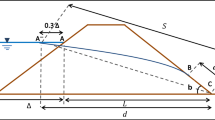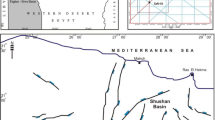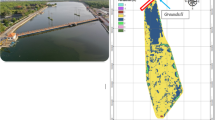Abstract
The fourth Plant of Daqing oilfield which uses ASP flooding has a serious foul water problem. So, scaling conditions were analyzed to discuss the petroleum production and oil–gas–water treatment. In the flooding process in stratum, scaling in the ASP flooding is because of chemical condition changes. The silica and aluminum irons in the rocks are dissolved in the formation water. It breaks the original ion balance and results in reservoir scaling and damage. Several influencing factors were analyzed by investigating scaling conditions in ASP flooding.
Similar content being viewed by others
Avoid common mistakes on your manuscript.
Introduction
After conventional water-flooding processes the residual oil in the reservoir remains as a discontinuous phase in the form of oil drops trapped by capillary forces and is likely to be around 70 % of the original oil in place (OOIP) (Dosher and Wise 1976). The EOR method so-called alkaline–surfactant–polymer (ASP) flooding has been proved to be effective in reducing the oil residual saturation in laboratory experiments and field projects through reduction of interfacial tension and mobility ratio between oil and water phases (Clark et al. 1988; Meyers et al. 1992; Vargo et al. 1999; Demin et al.1999). ASP is a new technique of enhanced oil recovery after polymer flooding. At present, industrial pilot testing and application of ASP are or will be implemented in most of the oilfields, mainly in Daqing (Feng et al. 2002; Guo et al. 2003). Recently, much intensive research has been done on ASP flooding both in China and worldwide, achieving some important accomplishments that lay a solid foundation for the extension of this technique to practical application in oil fields (Baviere et al. 1995; Thomas 2005; Yang et al. 2003; Li et al. 2003).
In ASP flooding the surfactant is responsible for reducing the interfacial tension between oil and water phases to a level that promotes the mobilization of trapped oil drops. The alkaline agent is intended to react with the acids to generate in situ surfactant (Rivas et al. 1997) to overcome the surfactant depletion in the liquid phases due to retention. The role of the polymer is to increase the viscosity, reduce the mobility ratio and hence allow a greater volumetric swept efficiency (Luis et al. 2005). Many surfactants require relatively high concentrations of alkali, for example, surfactant ORS-41 used in Daqing oilfield requires 0.8–1.4 wt% NaOH (1.2 wt% is adopted in practice). However, in the process of the injection of ASP solution, the use of alkali also brought new problems. The high concentration of alkali has brought about many problems such as the erosion of formation, the deposition of alkali scales, the reduction of productivity, and the sharp shortening of pump-checking cycle. In the pilot area of ASP flooding in Daqing Oilfield, after ASP flooding got effective, pump-sticking phenomenon due to alkali scales occur in most wells (Hou et al. 2005).
The alkaline chemical agent was injected into the strata, then affected by the factors such as formation temperature, pressure, ion and pH of the injection system and took place in various reaction with strata rock and formation water. It includes dissolution, mixture and ion exchange. On one hand, the sodium ion in the ASP liquid replace with the calcium and magnesium ion in the clay, and forming hydroxide deposition of calcium and magnesium. On the other hand, the strata rock contains the feldspar, illite, kaolinite and montmorillonite. Alkali can also work with these components and generate Si and Al ion. Then they entered the formation water, broke the ionic balance of original underground liquid, subsided with the formation of the new mineral with the change of the formation conditions, and generated a lot of aluminosilicate scale particle (Guo et al. 2006; Wang et al. 2011; Deng et al. 2009).
Aiming at scaling problems in injection instruments of ASP flooding, corresponding cleaning scale and profile control measures are urgently adopted. By the analysis of scaling mechanism in ASP flooding oilfield and characterization of the present profile control technique, the author is launching a survey on the scaling conditions for ASP flooding oilfield in the fourth Plant of Daqing oilfield. Several influencing factors are also analyzed by investigating scaling conditions in ASP flooding.
Materials and methods
Number calculation of silicon ions in the test area
The extended field test area of ASP flooding in west of Xingerlin of the fourth oil production plant was investigated. According to the amount of water and the concentration of silicon ions in the produced fluid, the total output of silicon ions was calculated which was 46.7 tons from June 1998 to June 2000. According to the total weight of reservoirs in central well area, the produced silicon weight from the formation only account for 0.55 in 10,000 of the total reservoir rock weight was calculated.
Effect of aluminosilicate ion concentration on scaling
The characteristics of ASP flooding system are that silicon ion content is high in produced water, and silica scale is mainly formed. Therefore, in test, the silicon ion concentration changes before and after the reaction act as the exploration indexes of scaling, that is, the more the decrease of silicon ion concentration in the reaction solution after the reaction is, the more the number of scaling silicon ions is.
Under the conditions of 45 °C reaction temperature and pH 11.5, the influence of aluminum–silicate ion concentration on scaling was investigated by simulating injection water, formation water and produced water, respectively, and changing the concentration of Si–Al ions in water samples (keeping a 3:1 ratio of Si ions to Al ions constant). The ion composition in three kinds of water is shown in Table 1.
Influence of aluminosilicate ion ratio on scaling
Under the conditions of 45 °C reaction temperature and pH 11.5, with the concentration (1,500 mg/L) of silicon ions kept constant, the influence of the proportion of Si ions to Al ions on scaling was investigated by respectively simulating injection water, formation water and produced water and changing the ratio of aluminum ions to silicon ions in the water samples.
Influence of the concentrations of calcium and magnesium ions on scaling
Under the conditions of 45 °C reaction temperature, pH 11.5, and a 3:1 ratio of silicon ions to aluminum ions in the solution, the influence of concentration of calcium and magnesium ions on scaling was investigated by changing Ca2+ and Mg2+ concentrations.
Influence of temperature on scaling
In the conditions of a 3:1 proportion of silicon ions to aluminum ions and pH 11.5, the influence of temperature on scaling was investigated by simulating produced water and changing the reaction temperature.
Influence of pH on scaling
In the conditions of a 3:1 proportion of silicon ions to aluminum ions and 45 °C reaction temperature, the influence of pH on scaling was investigated by simulating produced water and changing pH value.
Results and discussion
Influence of aluminosilicate ion concentration on scaling
It can be seen from Fig. 1 that with the increase of aluminosilicate ion concentration in three kinds of simulation water before reaction, the scaling number of silicon ions increases, indicating that the greater the concentration of aluminosilicate ions in solution before reaction, the more severe the scaling; it can also be seen that with the same Si–Al ion concentration, the order of silicon ion scaling amount in the three kinds of analog water is: injected water < formation water < produced water, so produced water is easy to scale than the other two kinds of water. And it can be sure that in the reaction conditions, the concentration of silicon ions is about 310 mg/L as scaling starts.
Influence of the ratio of aluminum ions to silicate ions on scaling
The results in Fig. 2 show that under the same other conditions, with the increase of ratio of Al3+:Si4+ in the solution (i.e., increase in the aluminum ion content), the amount of silicon ion scaling in the reaction solution increases, indicating that the ratio of aluminum ions to silicon ions also has some impact on scaling, and aluminum ions can also promote the formation of silica scaling.
Influence of calcium and magnesium ion concentrations on scaling
Table 2 shows that when silicon ions exist independently, almost no precipitation is generated, in other words, concentration of silicon ions in the solution remains essentially unchanged before and after the reaction. When there exist Ca2+ and Mg2+ in the solution, the scaling amount of silicon ions significantly increases with the increase of their concentrations. This is because under the condition of higher pH value, Ca2+ and Mg2+ form carbonate or hydroxide precipitation, and these precipitates will become the cores of silica scale deposition to promote the generation of silica scale.
Influences of temperature on scaling
Figure 3 indicates that temperature has a larger effect on scaling. With the rise of reaction temperature, the starting concentration of silicon ion scaling decreases, showing that the higher the temperature, the easier the scaling. And in less than 45 °C temperature range, the trend is relatively small, and the downward trend significantly increases when the temperature exceeds 45 °C.
Influences of PH on scaling
Figure 4 shows that in low pH value range, the starting concentration of silicon ion scaling increases with the pH, and when the pH >11.5, the starting concentration of silicon ions scaling decreases with the pH. This is because the saturated solubility of silicon ions increases with the increase of pH value, but when the pH is higher, the precipitation trends of calcium and magnesium ions are enhanced in the solution, and calcium and magnesium ions precipitates will become the cores of silica scale deposition to promote the formation of silica scale and reduce the starting concentration of silicon ion scaling.
Conclusions
-
1.
The increasing scaling amount of silicon ions indicates that the greater the concentration of aluminosilicate ions in solution before reaction, the more severe the scaling.
-
2.
If the concentrations of Si ions and Al ions are the same, the scaling amount order of silicon ions in the three kinds of analog water is: injected water < formation water < produced water, so produced water is easiest to scale; it can be sure that in this reaction condition, the concentration of silicon ions is about 310 mg/L when scaling starts.
-
3.
The influencing factors of scaling in ASP flooding were determined, that is, the greater the concentrations of silicon, aluminum, calcium, magnesium ions in the solution, the higher the reaction temperature and the higher pH value (ASP flooding conditions, namely the pH value between 11.3 and 13.5), the longer the reaction time and the more serious the scaling.
References
Baviere M, Glenat P, Plazanet V, Labrid J (1995) SPE Res Eng 10:187–193
Clark SR, Pitts MJ, Smith SM (1988) Paper SPE 17538 presented at the spe rocky mountain regional meeting, Casper, WY
Demin W, Jie Ch, Jun ZW, Zhen Y, Hong FL (1999) Kuala Lumpur, Malaysia
Deng SB, Yu G, Chen ZX, Wu D, Xia FJ, Jiang N (2009) Colloid Surf A 332:63–69
Dosher TM, Wise FA (1976) J Petrol Sci Technol :575
Feng FX, Dou T, Shi YJ, Xiao YZ (2002) Acta Petrolei Sinica 15:75–78
Guo YL, Wang YX, Cai HS (2003) J China Univ Geosci 28:517–521
Guo J, Liu Q, Li Wu MZ, Christy AA (2006) Colloid Surf A 273:213–218
Hou JR, Liu ZC, Zhang SF, Yue XA, Yang JZ (2005) J Pet Sci Eng 47:219–235
Li H, Liao G, Han H et al (2003) SPE international improved oil recovery conference in Asia Pacific, Kuala Lumpur, 20–21 October
Luis E, Zerpa NV, Queipoa T, Pintos S, Salager JL (2005) J Pet Sci Eng 47:197–208
Meyers JJ, Pitss MJ, Wyatt K (1992) SPE/DOE 8th symposium on enhanced oil recovery, Tulsa, Oklahoma
Rivas H, Gutierrez X, Zirrit JL, Antón, RE, Salager JL (1997) Industrial applications of microemulsions. 305–329
Thomas S (2005) SPE distinguished lecture
Vargo J, Turner J, Vergnani B, Pitts M, Wyatt K, Surkalo H, Patterson D (1999) SPE rocky mountain regional meeting, Gillette, Wyoming
Wang B, Wu T, Li YJ, Sun DJ, Yang M, Gao YX (2011) Colloid Surf A 379:121–126
Yang XM, Liao G, Han P, Yang Z, Yao Y (2003) Asia Pacific Oil and Gas Conference and Exhibition, Jakarta. 9:9–11
Acknowledgments
The research is financially supported by Scientific Research Fund of Heilongjiang Provincial Education Department (No.12521047).
Author information
Authors and Affiliations
Corresponding author
Rights and permissions
Open Access This article is distributed under the terms of the Creative Commons Attribution License which permits any use, distribution, and reproduction in any medium, provided the original author(s) and the source are credited.
About this article
Cite this article
Jing, G., Tang, S., Li, X. et al. The scaling conditions for ASP flooding oilfield in the fourth Plant of Daqing oilfield. J Petrol Explor Prod Technol 3, 175–178 (2013). https://doi.org/10.1007/s13202-013-0061-2
Received:
Accepted:
Published:
Issue Date:
DOI: https://doi.org/10.1007/s13202-013-0061-2








